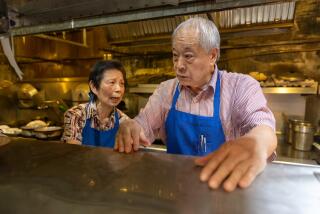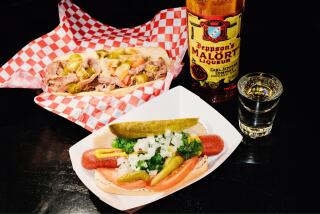Chicagoans Hurry to Savor a Last Bite of City’s History
CHICAGO — Warmed by a heavy overcoat and decades of savory memories, Shelton Latmer waited tearfully Thursday outside the Berghoff.
For about 40 years, he has regularly stopped at the city’s oldest restaurant for a platter of piping hot Wiener schnitzel, or to dig into a bowl of slightly bitter red cabbage and a dish of luscious creamed spinach.
Whenever there was something to celebrate -- his 21st birthday, his first job, the birth of his last grandchild -- Latmer said he would come to the corner of West Adams and South State streets, step up to the dark-wood bar and heft a mug of the Berghoff’s own Dortmunder-style brew. It was, after all, a tradition at the restaurant known for obtaining the city’s first post-Prohibition liquor license.
Now, in a move that has shocked Chicagoans, the Berghoff family has decided to shut its doors after 107 years. Its last day is Feb. 28.
“A Chicago without Berghoff’s is like a Chicago without the wind,” said Latmer, 52, a former stockbroker. “It’s part of this city’s heritage.”
To see it close, “It makes me sick,” he said.
The demise of the beloved eatery is the latest in a string of endings among city icons -- including the pending closure of the City News Service, a scrappy news outlet where author Kurt Vonnegut once worked, and the loss of Marshall Field’s department store, being revamped next year into a Macy’s.
But such closures come at a time when downtown Chicago is booming, and the number of commercial and residential projects are on the rise. More people live within walking distance of the Berghoff now than have lived in the area in many decades, noted Bill Savage, senior lecturer in the English Department at Northwestern University and an expert in Chicago history.
“Change is a double-edged sword: New things come and old things go away,” Savage said. “What people are mourning isn’t necessarily the loss of schnitzel or strudel. It’s about losing the ability to experience a place where our fathers and grandfathers gathered. It’s about losing things that connect us to the past, both to the history of the city and the individual’s history of the city.”
Indeed, closing the restaurant was not done for economic reasons, the family says. There’s typically a 30-minute wait to get seated, and food experts say it’s believed to be one of the most profitable eateries in this culinary town.
The family owns the enormous 48,000-square-foot commercial space, from the ornate stained-glass surrounding the family name at the entrance, to the framed photographs of the Columbian Exposition that line the walls.
Herman Berghoff and his wife, Jan -- the third generation to run the restaurant -- said in a statement that they’re simply retiring from the food world.
“It’s been an honor to be a part of the fabric of Chicago, but after being in the business for over half a century, Jan and I feel that now is the right time to start a new chapter in our lives,” Herman Berghoff, 70, said Wednesday in the statement.
Part of the business will be continued, thanks to a fourth-generation Berghoff.
The couple have leased the space to their daughter, 44-year-old Carlyn Berghoff, a caterer.
Her downtown firm needed to find a new home, after the landlord of her building bought out the lease. Carlyn plans to open a new bar, naming it “17 West at the Berghoff,” and launch a cafe in the neighboring space. The main restaurant space will be used for her catering business and for private events.
Although her parents sold her most of the restaurant’s possessions -- white linen tablecloths, centuries-old beer steins, and scores of hand-tooled, rich oak decorations -- the recipes weren’t included in the sale, said restaurant spokesman Chris Lackner.
That news had thousands of German-food fans racing to the restaurant Thursday, many happy to wait an hour or more to grab a bite and reminisce.
At lunchtime, a wet and cool wind had customers shivering in a line that stretched down the block. Many people passed the time by swapping tales about meals and memories in their past.
“I remember when the bar used to be only for men,” said Carol Estes, 46, a housewife who lives in South Chicago. “I was way too young to go in, of course. But I still remember my mother laughing when those women from [the National Organization for Women] walked in and sat down back in 1969, and demanded a drink.”
Tracey Melner, 49 and a neighbor of Estes, grinned.
“It was the death of the ‘boys only no girls allowed’ club,” Melner said. “Ha, ha! Served them right!”
Standing nearby, Anthony Steele rolled his eyes and sighed.
“You can’t stop progress, I suppose,” said Steele, 59.
Restaurateurs rolled into Chicago in the mid-1800s with the railroads, as the city became the nation’s railway transfer point.
As train cars loaded full of ingredients -- milk and butter from Midwestern farms, spices from Latin America, sugar from the east -- rumbled into town, so too came immigrants looking for work.
They brought their recipes with them.
“At one time, Chicago was among the biggest bastions of German cooking, because there were so many Germans here working in the steel mills,” said Robert Scarola, author of “Make Mine Medium Rare: A Diner’s Survival Guide.”
The restaurant’s founder, Herman Joseph Berghoff, immigrated to the U.S. in 1870 from Germany, and began brewing his family’s beer recipe in Fort Wayne, Ind. He and his three brothers decided to move to Chicago, after setting up a booth at the World’s Columbian Exposition in 1893 and wooing fairgoers with cups of the cool beverage.
They started out selling beer for a nickel, and threw a sandwich in for free.
The family relocated to its current home after the beginning of Prohibition, which forced the Berghoffs to expand the bar into a full restaurant to stay financially afloat. The family continued to make its own beverages: A soda pop and a nonalcoholic beer
The restaurant got its liquor licenses in 1933. Today, those licenses remain stuck to panes of glass in an alcove in the dining room.
As the decades passed, the city’s restaurants changed as its ethnic make-up shifted. So too, said Scarola, did American eating habits.
“German cooking is about heavy foods. It’s heavy in creams, heavy in meats, heavy in carbohydrates, a heavy meal that’s simply not healthy,” said Scarola, the food writer. “Other than Italian cooking, the United States has turned its back on heavy cooking.
“When you talk about the city once known for German cuisine losing the last of its great German restaurants, you’re talking about an ethnic cuisine dying.”
But for those waiting to get into the Berghoff, it’s not over yet.
After 40 minutes in line, Latmer, the former stockbroker, made his way past formally attired waiters bustling through the crowded dining room, carrying platters teeming with veal schnitzel, spinach and strudel.
He sat down and picked up the menu.
More to Read
Eat your way across L.A.
Get our weekly Tasting Notes newsletter for reviews, news and more.
You may occasionally receive promotional content from the Los Angeles Times.







